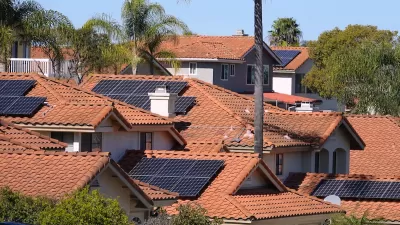Combining both solar power and kinetic energy, the first public phone charging station of its kind was recently installed at Webster University in St. Louis, Missouri.
As covered by Adele Peters of Fast Co.Exist, about two million pay phones have been removed across the United States since 2000. As the ubiquity of mobile phones rises, more public phone charging stations are taking their place instead. A startup from San Francisco called Volta Group recently released the EnGo, which is doing exactly that. CEO of Volta Group, Petar Mirovic explains why the combination of solar and kinetic energy is ideal: "if you have just solar panels, you'll have days without sun. At the same time, we saw a huge potential in further developing kinetic energy tiles. In areas like Manhattan, or other busy areas, there's a waste of footsteps that can be used in a better way."
The charging stations can accommodate "up to 14 different devices at a time, and includes commonly used cables that can easily be swapped out as technology changes, along with wireless charging pads. Of course, it's not exactly like a phone booth." With this in mind, the station is equipped with free Wifi, an emergency intercom, and display screens with maps and ads.
Over the next six months Volta Group plans to install 100 EnGos throughout the country.
FULL STORY: A Public Phone Charging Station That Harnesses Power From Pedestrians' Footsteps

Planetizen Federal Action Tracker
A weekly monitor of how Trump’s orders and actions are impacting planners and planning in America.

San Francisco's School District Spent $105M To Build Affordable Housing for Teachers — And That's Just the Beginning
SFUSD joins a growing list of school districts using their land holdings to address housing affordability challenges faced by their own employees.

The Tiny, Adorable $7,000 Car Turning Japan Onto EVs
The single seat Mibot charges from a regular plug as quickly as an iPad, and is about half the price of an average EV.

Seattle's Plan for Adopting Driverless Cars
Equity, safety, accessibility and affordability are front of mind as the city prepares for robotaxis and other autonomous vehicles.

As Trump Phases Out FEMA, Is It Time to Flee the Floodplains?
With less federal funding available for disaster relief efforts, the need to relocate at-risk communities is more urgent than ever.

With Protected Lanes, 460% More People Commute by Bike
For those needing more ammo, more data proving what we already knew is here.
Urban Design for Planners 1: Software Tools
This six-course series explores essential urban design concepts using open source software and equips planners with the tools they need to participate fully in the urban design process.
Planning for Universal Design
Learn the tools for implementing Universal Design in planning regulations.
Smith Gee Studio
City of Charlotte
City of Camden Redevelopment Agency
City of Astoria
Transportation Research & Education Center (TREC) at Portland State University
US High Speed Rail Association
City of Camden Redevelopment Agency
Municipality of Princeton (NJ)





























